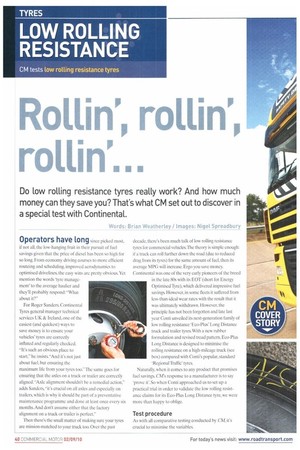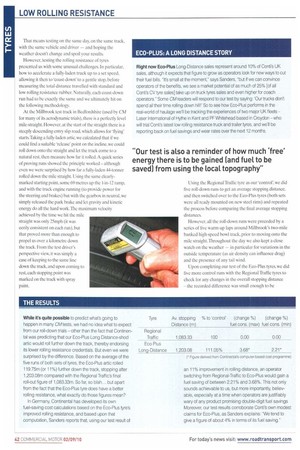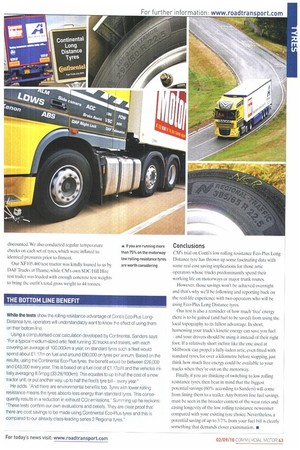Rollin', roilin; rollin'..,
Page 40

Page 42

Page 43

If you've noticed an error in this article please click here to report it so we can fix it.
Do low rolling resistance tyres really work? And how much money can they save you? That's what CM set out to discover in a special test with Continental.
Words: Brian Weatherley / Images: Nigel Spreadbury Operators have long since picked most, if not all. the low-hanging fruit in their pursuit of fuel savings given that the price of diesel has been so high for so long. From economy driving courses to more efficient routeing and scheduling, improved aerodynamics to optimised drivelines, the easy wins are pretty obvious. Yet mention the words 'tyre management' to the average haulier and they'll probably respond: "What about it?"
For Roger Sanders, Continental Tyres general manager technical services UK & Ireland, one of the easiest (and quickest) ways to save money is to ensure your vehicles' tyres are correctly inflated and regularly checked. "It's such an obvious place to start," he insists, "And it's not just about fuel, but ensuring the maximum life from your tyres too." The same goes for ensuring that the axles on a truck or trailer are correctly aligned. "Axle alignment shouldn't be a remedial action," adds Sanders, "it's crucial on all axles and especially on trailers, which is why it should be part of a preventative maintenance programme and done at least once every six months. And don't assume either that the factory alignment on a truck or trailer is perfect."
'then there's the small matter of making sure your tyres are mission-matched to your truck too. Over the past decade, there's been much talk of low rolling resistance tyres for commercial vehicles:The theory is simple enough: if a truck can roll further down the road (due to reduced drag from its tyres) for the same amount of fuel, then its average MPG will increase. Ergo you save money. Continental was one of the very early pioneers of the breed in the late 80s with its EOT (short for Energy Optimised Tyre), which delivered impressive fuel savings. However, in some fleets it suffered from less-than-ideal wear rates with the result that it was ultimately withdrawn, However, the principle has not been forgotten and late last year Conti unveiled its next-generation family of low rolling resistance `Eco-Plus" Long Distance truck and trailer tyres. With a new rubber formulation and revised tread pattern, Eco-Plus Long Distance is designed to minimise the rolling resistance on a high-mileage truck (see box) compared with Conti's popular, standard 'Regional Traffic' tyres.
Naturally, when it comes to any product that promises fuel savings, (M's response to a manufacturer is to say 'prove it'. So when Conti approached us to set up a practical trial in order to validate the low rolling resistance claims for its Eco-Plus Long Distance tyre, we were more than happy to oblige.
Test procedure As with all comparative testing conducted by CM, it's crucial to minimise the variables.
That means testing on the same day, on the same track. with the same vehicle and driver — and hoping the weather doesn't change and spoil your results However, testing the rolling resistance of tyres presented us with some unusual challenges. In particular, how to accelerate a fully-laden truck up to a set speed, allowing it then to 'coast-down' to a gentle stop, before measuring the total distance travelled with standard and low rolling resistance rubber. Naturally, each coast-down run had to be exactly the same and we ultimately hit on the following methodology.
At the Millbrook test track in Bedfordshire (used by CM for many of its aerodynamic trials), there is a perfectly level mile-straight. However, at the start of the straight there is a steeply descending entry slip road, which allows for 'flying' starts.Taking a fully-laden artic, we calculated that if we could find a suitable 'release' point on the incline, we could roll down onto the straight and let the truck come to a natural rest, then measure how far it rolled. A quick series of proving runs showed the principle worked although even we were surprised by how far a fully-laden 44-tonner rolled down the mile straight. Using the same clearlymarked starting point, some 69 metres up the I-in-12 ramp, and with the truck engine running (to provide power for the steering and brakes) but with the gearbox in neutral, we simply released the park brake and let gravity and kinetic energy do all the hard work. The maximum velocity achieved by the time we hit the mile straight was only 25inph (it was eerily consistent on each run), but that proved more than enough to propel us over a kilometre down the track. From the test driver's perspective view, it was simply a case of keeping to the same line down the track, and upon coming to rest, each stopping point was marked on the track with spray paint. Using the Regional Traffic tyre as our 'control', we did five roll-down runs to get an average stopping distance, and then switched over to the Eco-Plus tyres (both sets were all ready mounted on new steel rims) and repeated the process before comparing the final average stopping distances.
However, all the roll-down runs were preceded by a series of five warm-up laps around Millbrook's two-mile banked high-speed bowl track, prior to moving onto the mile straight. Throughout the day we also kept a close watch on the weather — in particular for variations in the outside temperature (as air density can influence drag) and the presence of any tail wind.
Upon completing our test of the Eco-Plus tyres, we did five more control runs with the Regional Traffic tyres to check for any changes in the overall stopping distance the recorded difference was small enough to he
discounted. We also conducted regular temperature A If you are running more checks on each set of tyres, which were inflated to than 75% on the motorway identical pressures prior to fitment. tow rotting resistance tyres Our XFl 05.460 test tractor was kindly loaned to us by are worth considering DAF Trucks at Thame, while (TM's own SDC/Hill Hire test trailer was loaded with enough concrete test weights to bring the outfit's total gross weight lo 44 tonnes.
Conclusions
Oils trial on Conti's low rolling resistance Eco-Plus Long Distance tyre has thrown up some fascinating data with some real cost-saving implications for those artic operators whose trucks predominantly spend their working life on motorways or major trunk routes.
However, those savings won't he achieved overnight and that's why we'll be following and reporting back on the real-life experience with two operators who will be using Eco-Plus Long Distance tyres.
Our test is also a reminder of how much 'free' energy there is to be gained (and fuel to be saved) from using the local topography to its fullest advantage. In short, harnessing your truck's kinetic energy can save you fuel — and your drivers should be using it instead of their right foot. If a relatively short incline like the one used at Millbrook can propel a fully-laden artic, even fitted with standard tyres, for over a kilometre before stopping, just think how much free energy could be available to your trucks when they're out on the motorway.
Finally, if you are thinking of switching to low rolling resistance tyres, then bear in mind that the biggest potential savings (60% according to Sanders) will come from fitting them to a trailer. Any bottom line fuel savings must be seen in the broader context of the wear rates and casing longevity of the low rolling resistance newcomer compared with your existing tyre choice. Nevertheless, a potential saving of up to 3,7% from your fuel bill is clearly something that demands closer examination. •
























































































































































































































































